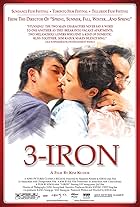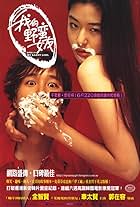Spring, Summer, Fall, Winter... and Spring
Original title: Bom yeoreum gaeul gyeoul geurigo bom
In the midst of the Korean wilderness, a Buddhist master patiently raises a boy while teaching wisdom and compassion through experience and endless exercises.In the midst of the Korean wilderness, a Buddhist master patiently raises a boy while teaching wisdom and compassion through experience and endless exercises.In the midst of the Korean wilderness, a Buddhist master patiently raises a boy while teaching wisdom and compassion through experience and endless exercises.
- Awards
- 15 wins & 9 nominations total
Oh Yeong-su
- Old Monk
- (as Young-soo Oh)
Seo Jae-kyeong
- Boy Monk
- (as Jae-kyeong Seo)
Ji Dae-han
- Detective Ji
- (as Dae-han Ji)
- Director
- Writer
- All cast & crew
- Production, box office & more at IMDbPro
Storyline
Did you know
- TriviaThe inscription on the floor is "The Heart Sutra", one of the most important Sutra of Mahayana Buddhism, written in literary Chinese.
- GoofsWhen the young monk finishes inscribing the Heart Sutra on the floor and falls down exhausted, the inscriptions below him change between shots (even though he is lying motionless). In one shot, the inscriptions he is lying on have been painted; and as he wakes up, the paint is gone.
- Alternate versionsThe local Korean version of this film is approximately 90 seconds longer than the International release; a sequence was removed near the end of the film (at about the 100-minute point). This is reflected in the DVD releases, as the Tartan R2 (UK) release and the Columbia/Tristar R1 (USA) release use the International cut of the film, while the Bitwin R3 (Korean) DVD uses the original cut.
- ConnectionsFeatured in Arirang (2011)
- SoundtracksJeongseon Arirang
Traditional
Performed by Kim Young Im
Featured review
At the risk of boring you all senseless here are some observations off the top of my head.
THE HUT Representing the self. All the possessions and shelter needed is on the floating hut. When the young man can no longer live at peace and comfort in the hut then bad things transpire. He never commits lustful acts in the hut. When we seek happiness outside ourselves, we are never truly content.
THE DOORS The doors by the lakeside and in the hut are symbolic rather than prescriptive. The fact there are no walls means their use is not forced but elected. They represent morality and discipline. Morality is not defined by a higher power but by society and the self. By adopting the constraints the doors engender, self-discipline is attained. As soon as the young man transgresses these self-imposed boundaries, to sneak across to the young woman, then disaster follows.
THE DEAD ANIMALS The Master allows the young boy to let the animals die. He does not become an all powerful father figure, cleaning up after him, but allows him to make mistakes and suffer the consequences. Buddhism does not have a higher power but rather promotes self-awareness.
THE MILLSTONE AND BUDDHA Represent the twin stones of regret for killing the fish and the snake. What you do unto others, you do unto yourself. He has carried that karma around with him all his life until he transcends them both, carrying them to the top of the hill, near heaven. Here he cuts himself free and attains redemption through struggle.
THE MASTER Is a great teacher, but does not lecture. Hardly a word is spoken, but lessons are learned. A good teacher points the way for a student to discover self-evident knowledge for themselves.
THE MOTHER The veil, representing guilt and shame are ultimately the cause of her downfall. Hiding from the outside world can bring about ruin.
THE YOUNG BOY Both at the beginning and the end, represents us. A good life is attained not by the absence of bad thoughts, but rather by their mastery, so they have no hold over us. We choose our behaviour rather than it choose us. The new boy is not born without sin, but rather must walk his own path to divinity. The same actor playing the young boy show the eternal cycle of the human soul.
THE SEASONS The endless cycle of birth, growth and death.
THE HUT Representing the self. All the possessions and shelter needed is on the floating hut. When the young man can no longer live at peace and comfort in the hut then bad things transpire. He never commits lustful acts in the hut. When we seek happiness outside ourselves, we are never truly content.
THE DOORS The doors by the lakeside and in the hut are symbolic rather than prescriptive. The fact there are no walls means their use is not forced but elected. They represent morality and discipline. Morality is not defined by a higher power but by society and the self. By adopting the constraints the doors engender, self-discipline is attained. As soon as the young man transgresses these self-imposed boundaries, to sneak across to the young woman, then disaster follows.
THE DEAD ANIMALS The Master allows the young boy to let the animals die. He does not become an all powerful father figure, cleaning up after him, but allows him to make mistakes and suffer the consequences. Buddhism does not have a higher power but rather promotes self-awareness.
THE MILLSTONE AND BUDDHA Represent the twin stones of regret for killing the fish and the snake. What you do unto others, you do unto yourself. He has carried that karma around with him all his life until he transcends them both, carrying them to the top of the hill, near heaven. Here he cuts himself free and attains redemption through struggle.
THE MASTER Is a great teacher, but does not lecture. Hardly a word is spoken, but lessons are learned. A good teacher points the way for a student to discover self-evident knowledge for themselves.
THE MOTHER The veil, representing guilt and shame are ultimately the cause of her downfall. Hiding from the outside world can bring about ruin.
THE YOUNG BOY Both at the beginning and the end, represents us. A good life is attained not by the absence of bad thoughts, but rather by their mastery, so they have no hold over us. We choose our behaviour rather than it choose us. The new boy is not born without sin, but rather must walk his own path to divinity. The same actor playing the young boy show the eternal cycle of the human soul.
THE SEASONS The endless cycle of birth, growth and death.
- rupertbreheny
- Apr 27, 2004
- Permalink
- How long is Spring, Summer, Fall, Winter... and Spring?Powered by Alexa
Details
- Release date
- Countries of origin
- Official site
- Language
- Also known as
- Spring, Summer, Fall, Winter... And Spring
- Filming locations
- Production companies
- See more company credits at IMDbPro
Box office
- Gross US & Canada
- $2,380,788
- Opening weekend US & Canada
- $42,561
- Apr 4, 2004
- Gross worldwide
- $8,842,229
- Runtime1 hour 43 minutes
- Color
- Sound mix
- Aspect ratio
- 1.85 : 1
Contribute to this page
Suggest an edit or add missing content

Top Gap
By what name was Spring, Summer, Fall, Winter... and Spring (2003) officially released in Canada in French?
Answer
































